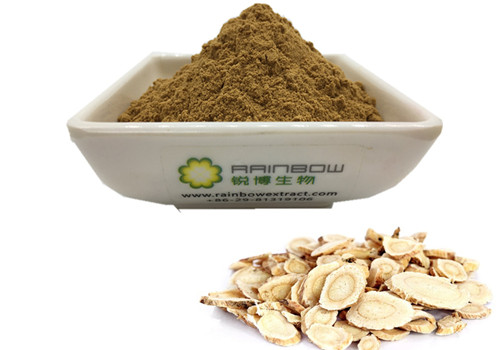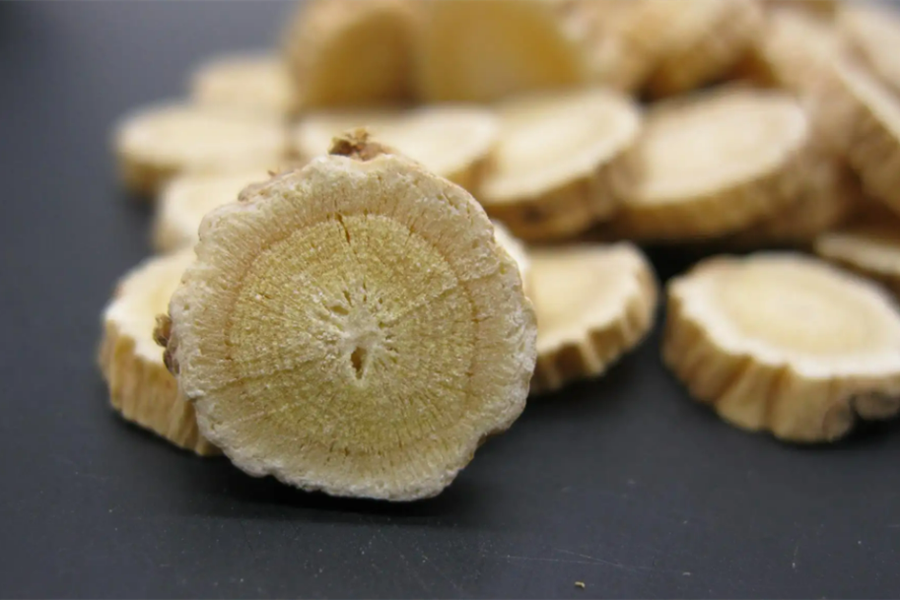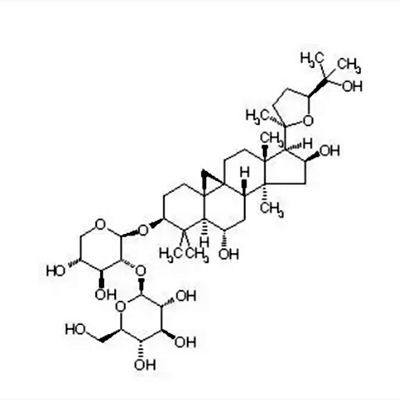The flowering plant Astragalus has been used as a natural remedy for a variety of ailments for thousands of years. In traditional Chinese medicine, it is regarded as an adaptogen, a natural substance that improves the body’s ability to cope with various stressors. The chemical constituents of astragalus seem to stimulate the immune system and reduce inflammation and swelling. Astragalus membranaceus contains polysaccharides, saponins, flavonoids, amino acids and other active components, which can promote antibody generation and immune response.
What’s Astragalus polysaccharides?
|
2-(Chloromethyl)-4-(4-nitrophenyl)thiazole 2-(CHLOROMETHYL)-4-(4-NITROPHENYL)-1,3-THIAZOLE |
|
| Molecular formula | C10H7ClN2O2S |
| Molecular weight | 254.69300 |
| CAS no | 89250-26-0 |
| Density | 1.439 g/cm3 |
| Melting point | DHS 154.5ºC |
| Boiling point | 406.2ºC at 760 mmHg |
| Refractive index | 1.638 |
Astragalus Polysaccharides (APS) is one of the main active components of Astragalus membranaceus, which is a water-soluble heterosaccharide formed by extraction, separation, concentration and purification of the root of Astragalus membranaceus. It is a light yellow powder composed of hexuronic acid, glucose, fructose, rhamnose, arabinose, galacturonic acid and glucuronic acid. It can be used as an immune promoter or regulator and has anti-virus, anti-tumor, anti-aging, anti-radiation, anti-stress, anti-oxidation and other effects. Glucose is the predominant component, with some rhamnose, galactose, and arabinose included, is the most abundant polysaccharide in Astragalus, followed by galactose and arabinose. The Astragalus polysaccharides are also a good source of antioxidants and are used as a dietary supplement in the treatment of various illnesses. The chemical composition of Astragalus polysaccharides extract differs according to their extraction and purification methods. Here we introduced the methods how were the Astragalus polysaccharides extracted and what was used for?
Extraction Methods of Astragalus Polysaccharides

Astragalus
Distilled Water Extraction
Astragalus polysaccharides is dissolved in water and insoluble in ethanol macromolecular compounds, most of the manufacturers: extracted with the use of distilled water process is place in distilled water to boil after crushing astragalus root astragalus polysaccharide dissolved in water, change its pH is neutral, after the merger filtrate concentrated ethanol precipitation separation of polysaccharide from extract, acetone, washing coarse polysaccharide resulting from the frozen and vacuum drying. This extraction method is simple and easy to operate, but it can extract flavonoids, saponins and other chemicals in the astragalus at the same time. These substances are easy to be oxidized and discolored in the air, affecting the purity and color of the product. The extraction cost is high and the output efficiency is about 2.5%.
Alkaline Extraction
As a component of astragalus membranaceus fiber, the extraction efficiency depends on the swelling and solubility of astragalus membranaceus fiber. The swelling and solubility of the fibers in alkali were significantly increased compared with that in water, and the ester bonds between the fibers were easily broken under alkaline conditions, leading to peeling reaction and more polysaccharides could be extracted. Therefore, astragalus polysaccharides are mostly extracted from water and weak base solutions at different temperatures. Generally, CaO or Na2CO3 aqueous solution with pH 9~10 is boiled for extraction, and the concentration time is about pH 6.5. Ethanol with a certain concentration is added for centrifugation. After water dissolution and filtration, ethanol precipitation, acetone washing, freezing or vacuum drying are used to obtain crude polysaccharides.
The results showed that astragalus polysaccharides were extracted by alkali-ethanol precipitation and alkali-ethanol extraction precipitation. The crude astragalus polysaccharides were purified by different flocculants. The polysaccharide content was determined by the phenol-concentrated sulfuric acid method. ZTC1+1 natural clarifier ⅱ could remove impurities in APS extract and improve the purity of APS. Since alkalinity may affect the spatial structure of polysaccharides, further study is needed.
Microwave Extraction
Microwave refers to electromagnetic waves with a frequency of 300MHz to 300GHz, that is, electromagnetic waves with a wavelength between 1 meter and 1 millimeter. Microwave has strong penetration, high selectivity, and high heating efficiency, microwave radiation can greatly accelerate the reaction speed, reaction time in minutes, or seconds. When microwave technology is applied to a plant cell wall, its thermal effect can break the cell wall and inactivate enzymes in the cell membrane, and polysaccharide can be extracted easily through cell wall and cell membrane barrier, which can effectively improve the extraction rate of polysaccharide. Microwave has a good auxiliary effect on the extraction of APS, can reduce the amount of extraction agent, shorten the extraction time and improve the yield of polysaccharides, in many aspects better than the traditional direct heating method.
Chinese scholars used the extraction rate of astragalus polysaccharides as the index to study the ultrasonic-assisted extraction process of astragalus polysaccharides by orthogonal test. The optimized conditions were determined as follows: solid-liquid ratio of 30∶1, the ultrasonic intensity of 120W and extraction time of 1h, and the optimal extraction rate of astragalus polysaccharides reached 92.1%.
Ultrasonic Extraction
Sound waves with frequencies higher than 20,000 Hertz are called “ultrasonics”. Ultrasonic has strong directivity, energy concentration and penetrating ability, which can spread in a variety of different media and can spread far enough distance. The mechanical crushing and cavitation of ultrasonic wave can easily disperse and destroy the plant tissue, accelerate the penetration of solvent through the tissue, improve the extraction rate of herbal active ingredients, and have the advantages of saving solvent, shortening extraction time and reducing energy consumption. However, side reaction is not easy to control and reaction equipment is expensive.
The results showed that astragalus root powder was used as a material to extract Astragalus polysaccharides by ultrasonic method, and the optimal extraction conditions were predicted as follows: extraction time 90 min, power 250 W, temperature 80℃.
Enzyme Extraction
Enzymes are proteins, RNA, or complexes that catalyze a specific chemical reaction. They are biocatalysts that speed up a reaction by reducing the activation energy of the reaction without changing the equilibrium point of the reaction. The commonly used enzyme preparations include cellulase, hemicellulase, pectinase and amylase, especially the application of cellulase through enzymatic hydrolysis reaction, can be relatively mild decomposition of plant tissues, destroy the dense structure of cell wall, accelerate the release and dissolution of medicinal active ingredients, improve the extraction rate of medicinally active ingredients.
Many astragalus polysaccharides manufacturers in China have used ultrasound combined with enzyme to effectively extract TOTAL APS. The results showed that the factors affecting the extraction rate of TOTAL APS were listed in the following order: ultrasonic extraction time, ultrasonic extraction temperature, enzyme content, solid-liquid ratio, The optimal extraction parameters were as follows: ultrasonic extraction time 30 min, ultrasonic extraction temperature 40℃, solid-liquid ratio 1∶20(g∶mL), enzyme content 10 mg.
The Applications Of Astragalus Polysaccharides
Animal Nutrition and Feed Processing
Animal experiments have proved that APS has excellent antiviral and antibacterial properties, which makes it immune stimulation, can promote the development of immune organs in mammals and aquatic animals, enhance the body specific and non-specific immunity, and can be used as immune enhancer. As a pig feed additive, APS can improve the survival rate and weaning weight of weaned piglets, inhibit intestinal harmful bacteria, reduce the incidence of diarrhea and enhance the immunity of piglets. In addition, 0.05% APS can significantly improve the immune effect of Newcastle disease and H9 subtype avian influenza vaccines.
Health Care
Aps can effectively improve the immune function of the body and stimulate the immune system to produce more immune cells, especially beneficial for patients with severe immune dysfunction. People who do not have enough sleep or poor physical strength can also take APS appropriately.
Skin Care
It’s no secret that astragalus has powerful antioxidant properties, and ancient Chinese women used astragalus decoction to fight age. It was found in mouse experiments that APS can promote the proliferation of rat intestinal mucosal microvascular endothelial cells cultured in vitro, and aps can significantly promote the proliferation of cells at low concentration. These results proved that APS has strong angiogenesis promoting effect and can promote wound healing.




